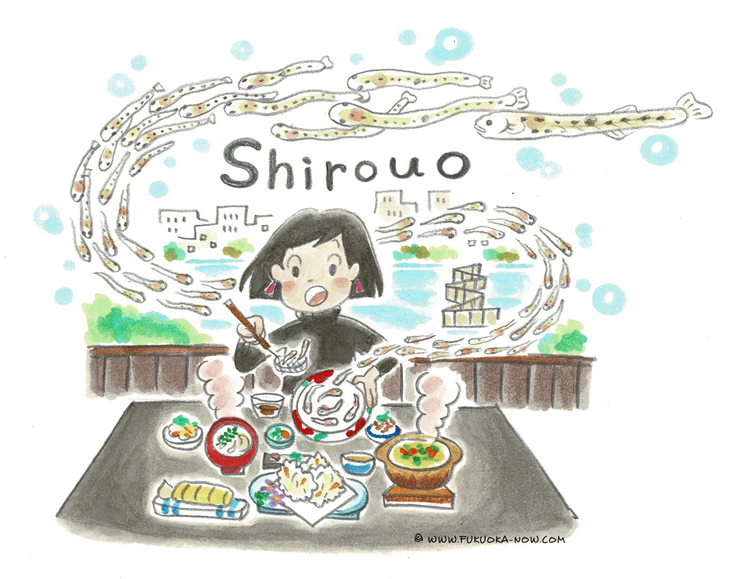Hakata Culture vol.156
Shiro-uo: A Harbinger of Spring

In Fukuoka, a tiny fish called the shiro-uo (or ice goby in English) is considered a harbinger of spring. It measures about 4-5 cm and is transparent. Although it is often mistaken with the shira-uo (or icefish in English) for a similar name and appearance, the shiro-uo belongs to a different family of fishes altogether. Upon closer inspection, you can see that the two fishes are shaped differently have differently shaped fins in particular.
Shiro-uo can be found throughout the oceans surrounding Japan and typically live in shallow areas near the coast. In late winter, they swim up rivers to lay their eggs beneath sand deposits. People throughout Japan have traditionally caught shiro-uo as they swim upstream, and the fish has long been considered an early spring delight. In Fukuoka, people are known to have been fishing for shiro-uo since the Edo era.
In early February, bamboo fish traps called yana are installed at the mouth of the Muromi River. These traps catch shiro-uo that swim into the river at high tide. This is a very old method of catching fish, and records indicate that it has been used in the Muromi River for at least 300 years. Nowadays, the Muromi River is the only place in Fukuoka Prefecture that still uses yana to catch shiro-uo, and the traps remain in place until mid-April.
Several restaurants that serve shiro-uo can be found along the river. Although they can be prepared in many ways, fried as tempura, added to soups, or boiled, one interesting way to eat shiro-uo is live! Just use the net provided to scoop up the live fish and gulp them down with a dab of soy sauce. The sensation is unique, to say the least. In any case, shiro-uo can only be enjoyed at this time of year, which is why they are considered a sign that spring is just around the corner.
シロウオ漁は春を告げる風物詩
福岡で春を告げる風物詩として知られているのがシロウオ漁です。シロウオはハゼ科の一種で、体長4~5センチの透明な体をした小魚です。漢字では「素魚」と書きます。生態や姿が似ているシラウオと間違えられることも多いのですが、こちらはシラウオ科という独立した一種に分類される小魚で、漢字では「白魚」と書きます。よく見るとヒレや全体の形も違います。
シロウオは日本近海に広く分布している魚で、普段は沿岸沿いの浅い海に生息しています。それが早春になると産卵のために川をさかのぼり、砂地の下に卵を産みます。この川をさかのぼるシロウオを捕まえて食用にする風習が各地にあり、古くから早春の味覚として知られてきました。とりわけ福岡市の室見川で行われるシロウオ漁は、江戸時代からの伝統がある漁として知られています。
2月上旬になると、室見川の河口に「梁(やな)」と呼ばれる仕掛けが現れます。竹で作った梁は古来から魚を捕る仕掛けとして使われてきたもので、室見川でも江戸時代から300年以上の歴史があるといわれています。これで満潮の上げ潮に乗って川をさかのぼるシロウオを捕まえます。現在、福岡県でシロウオ漁が行われているのは室見川だけで、漁は4月中旬まで続きます。
河畔にはシロウオを食べさせてくれる料理店も並んでいます。お吸い物、天ぷら、佃煮、卵とじなど、さまざまな調理法がありますが、中でも変わった食べ方が「踊り食い」です。生きたままのシロウオを網ですくい、酢醤油と一緒に口に流し込む食べ方で、口の中でピチピチとはねる独特の食感が体験できます。この時期にしか味わえないシロウオは、早春という季節を感じる料理なのです。

